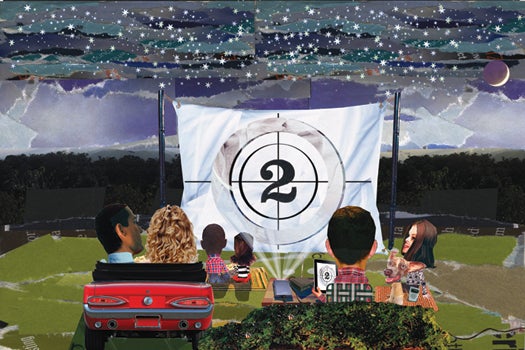Make Your Own DIY Drive-In
Seeing a movie outdoors used to be pretty simple. Drive a bit, pay at the entrance gate, find a parking...

Seeing a movie outdoors used to be pretty simple. Drive a bit, pay at the entrance gate, find a parking space, and wait for the towering images to flicker into view. Some nights you’d even get a double feature. But finding a drive-in isn’t easy these days. Just 370 remain in the U.S., down from a peak of nearly 5,000 in the 1950s. What to do if you yearn to experience the cinema outside? Create it yourself. For that, you need five elements: the power to drive the whole setup, a video source, a projector, a screen and a sound system. Here’s how I put together a cheap, portable screening for a group of friends over the summer.
POWER
Plugging your projector and video source into AC power will give you a better quality experience. But a battery-operated setup is more convenient. You can run power from an adapter connected to a car lighter or to a battery-powered worksite radio (see Sound).

Microvision SHOWWX Laser Projector
PROJECTOR
If you have AC power, try to borrow a presentation-style projector from your favorite PowerPoint wizard. For my ultra-portable setup, I chose the $150 Microvision SHOWWX laser projector. It operates on batteries and connects directly to my iPad (adapters for other devices are available as well).
MEDIA SOURCE
Some projectors have flash-memory slots, but connecting any device that can output a video file should work. I used my iPad because it’s easy to transfer movies to it, the battery and storage capacity are good, and you can buy simple video-out cables for it. If your movie is on a DVD, you’ll first need to rip the disc to a compatible format like MPEG-4 using software such as Handbrake, a free, cross-platform video converter. (Note that DVDs sold for home use are not licensed for public exhibition).
SCREEN
Try a white wall, a bed sheet or a white vinyl tablecloth. Aim for a screen width of about one sixth the distance to the back of the audience. Once you’ve got the screen, the next challenge is suspending it. I popped grommets into each corner of the tablecloth, securing the top to a pair of trees and the bottom to tent stakes.
SOUND
Old-fashioned drive-ins had the same sound choices you face: amplified or transmitted. You could plug into a portable guitar amp or a worksite radio, a ruggedized boombox designed to be heard over the din of machinery, such as the DeWalt DC012 ($160 at Amazon). But if you’ve got nearby neighbors, you’ll want to replicate the quieter old tune-in sound systems by using a low-power FM transmitter. Use one that’s capable of pumping out at least 10 milliwatts, which should get you a 50-foot range, such as the Ramsey FM10C ($45 at Amazon). Some models, including the C. Crane ($35; C. Crane), can be hacked to increase their output. If your soldering skills aren’t great, any electronics repair shop should be able to put one together quickly and cheaply.